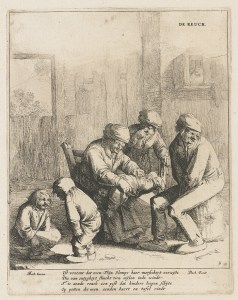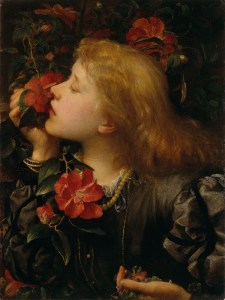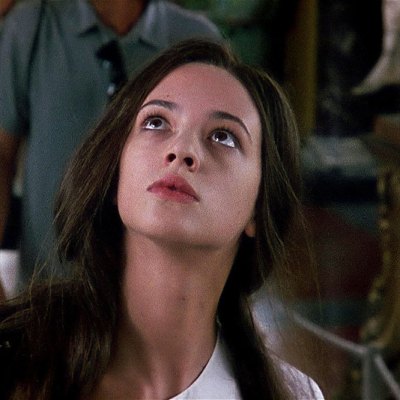This article was published in the May 2021 issue of Apollo. Preview and subscribe here.
At first glance Jacob van Ruisdael’s View of Haarlem with Bleaching Grounds (c. 1670–75) depicts a pleasant pastoral scene. Half of the painting – one of a series of popular Haerlempjes, or ‘Haarlem views’, for which Ruisdael was well known – is filled with sky, the billowing clouds emphasising the stark flatness of the Dutch landscape beneath. On the horizon lies the busy market town of Haarlem, dominated by the solid 15th-century Grote Kerk, which looms over the surrounding houses like a ship. In the foreground are a lake, trees and fields, on one of which bolts of linen have been laid out to bleach in the sun. It’s a beautiful detail. The bright white sheets cutting across the green and brown of the field give the painting an almost abstract geometry. Yet this formal beauty obscures one of the things that many contemporary viewers would have most associated with the bleaching fields: their overpowering, unavoidable stench.
View of Haarlem with Bleaching Grounds (c. 1670–75), Jacob van Ruisdael. Mauritshuis, The Hague

Bleaching, like many proto-industrial processes, was a deeply noisome activity (this was the main reason such work was usually banished to outside the city walls). Its particular olfactory signature – a combination of rank buttermilk and sharp lye – would have been familiar to most 17th-century noses. Ruisdael’s painting could be seen, therefore, as something of a visual joke, or at least a provocation. Regard this picturesque view, it seems to say, but be thankful you don’t have to smell the reality it depicts.
This tension – between the presence of smell as a subject for art and its inevitable absence as a sensory experience induced by paintings – was not uncommon during the Dutch Golden Age. In Pieter de Hooch’s Interior with Women beside a Linen Cupboard (1663), the clean domestic interior – spick-and-span flagstone floor, freshly washed linen, a child playing with her stick and ball – is undercut by the glimpse, through the door of the house, of a canal lurking in the background. Until the 19th century, such waterways would have functioned as public sewers, the odours of which, it was believed, were a threat to health. The smell of fetid water in cities was often so bad it forced wealthy citizens to flee their homes during the hot summer months. De Hooch’s painting is therefore both a reminder of the gross reality of scent and a kind of moral warning: that the sweet odours of domesticity might at any time be overcome by noxious whiffs from the dangerous world outside.
Interior with Women beside a Linen Cupboard (1663), Pieter de Hooch. Rijksmuseum, Amsterdam

In late February I sat in front of my laptop looking at De Hooch’s painting and sniffing a small plastic pot from which emanated the vegetative stench of stagnant canal. The smell had been produced to accompany a timely exhibition, in which both De Hooch’s and Ruisdael’s paintings feature. The curators of ‘Fleeting – Scents in Colour’ at the Mauritshuis (until 29 August) have worked with industrial chemists to recreate a range of odours – both foul and fragrant – that evoke something of the olfactory world of 17th-century Holland: the stench of sewage and the strong perfumes that were used to mask it; the smell of tobacco and rare spices, some of which were then being imported to Europe for the first time. Sniffing canal water while hunched over a laptop might not sound like a particularly attractive proposition (when the exhibition opens again after lockdown, viewers will be able to use pedal-operated atomisers to sample these smells while looking at the paintings) but what made the experience so memorable, I think, is that smelling strong odours – whether pleasant or unpleasant – is an increasingly rare experience in everyday life.
Smell (c. 1595), Jan Saenredam after Hendrick Goltzius. Rijksmuseum, Amsterdam

Smell (1635–38), Jan Both after Andries Both. Rijksmuseum, Amsterdam

The critics Martin Jay and Jonathan Crary have argued that over the last few hundred years we have become, in the developed world, less olfactorily literate than we once were. In post-Enlightenment Western culture, the eye is thought of as an organ of knowledge, associated with reading and therefore with thinking. We have come to privilege vision above the other senses, a bias reflected in the way that we often use visual metaphors when describing empirical experience (as in phrases such as ‘do you see it?’) and in the relative paucity of descriptive terms for smells in general.
This ocularcentrism is, perhaps unsurprisingly, particularly noticeable in the arts. Painters might be familiar with the smells of their materials (the earthy slap of linseed oil; the chemical bite of turps), but as viewers we are often forced to look at art against an olfactory backdrop that has been insistently, even aggressively, neutralised. This deodorisation has only been exacerbated during the Covid era. Not only has anosmia – the loss of the sense of smell – emerged as a key symptom of the virus, but the isolation of lockdown has separated us, olfactorily, from one another as never before. Behind our masks, in front of screens, our social lives have become almost completely odourless.
The paradox of smell is that it is both our most instinctive sense – intimate, familiar, evocative – and one that is particularly difficult to describe. Psychiatrists and philosophers have long thought it to be the sense that gets us closest to our animal selves. Sigmund Freud and the English sexologist Havelock Ellis both associated smell with sex: a result, they said, of the evolutionary separation, when humans became ambulatory, of the sex organs from the nose. Marcel Proust recognised smell to be a kind of memory portal, instantly transporting us through time. (Proust’s description of a madeleine-triggered sensory reverie in À la recherche du temps perdu has since been endorsed by neuroscientists, who have found close physiological connections between the ‘olfactory bulb’, the part of the brain responsible for processing scent, and the hippocampus: the seat of memory.)
The Raising of Lazarus (1310–11), Duccio di Buoninsegna. Kimbell Art Museum, Forth Worth

The association between scent and emotion makes it surprising that smell has not been a more popular subject in Western art. Until relatively recently, when artists did engage with smell they tended to treat it as a symbol (of sensuousness in general, or religious fervour) rather than as a source of aesthetic experience on its own terms. Often, in line with miasmatic theories of disease which held that illnesses were caused by bad smells, painted odours were warnings, rather than invitations to sniff. In The Raising of Lazarus (1310–11), Duccio depicts both the spiritual and physical discomfort of bringing a corpse back to life by foregrounding the repulsive olfactory qualities of death, with a figure near the front of the group delicately covering his nose to ward off the stench of decay. It is striking that, of the group approaching the grave, it is this figure who looks most alive – and yet he is also the most deceived about what his senses are telling him. This is really a devotional image about the fickleness of odour: an illustration of the way faith – and consequently art – triumphs over our instinctual bodily revulsions. In an inversion of the story of doubting Thomas, the painting asks us to trust what we see, not what we think we know (or smell).
The primacy of the visual was reflected in northern European art of the 16th and 17th centuries, too. When odour was taken up as an artistic subject – often through allegorical studies of the five senses – it became a means of demonstrating the technical facility of printmakers and painters. A collaboration between Rubens and Jan Brueghel the Elder, Allegory of the Sense of Smell (1617–18) shows an Edenic scene filled with sweet-smelling objects. In the foreground Venus smells a posy, while Cupid lifts a bouquet of flowers up to her nose. All around her lie other objects and animals associated with smell: vanilla pods, a hunting hound, even a civet cat, extracts from whose glands were used in perfumery. The painting is both a fragrant Wunderkammer and a kind of advertisement: look how close we can come to a visual evocation of the most indescribable sense, it seems to say.
Allegory of the Sense of Smell (1617–18), Peter Paul Rubens and Jan Brueghel the Elder. Museo del Prado, Madrid

Smell has often been thought to be a particularly ‘unshareable’ sense: ineffable in its workings, and therefore resistant both to literary and figurative description. Aristotle placed vision and hearing above odour in his hierarchy of the five classical senses, and both Kant and Hegel would follow suit, arguing that the ‘proximate senses’ of smell, taste, and touch could never form the basis of lasting art. For Hegel olfaction, unlike the ‘theoretical senses’ of vision and hearing, was too much connected with ‘the material and the unmediated sensual qualities of matter’ to ever be truly aesthetic.
Still Life with Symbols of the Virgin Mary (1672), Dirck de Bray. Museum Ons’ Lieve Heer op Solder, Amsterdam

There is a suspicion of earthy, bodily, even sexual pleasure in Hegel’s dismissal, one reflected in the zeal with which smells were, in the long aftermath of the Reformation, stripped from religious and cultural life. Two paintings in the Mauritshuis exhibition reflect this transition. Where Dirck de Bray’s Still Life with Symbols of the Virgin Mary (1672) associates Mary (represented by a sprig of rosemary and a blue flower) with the heavy scent of the thurible, Hendrick van Vliet’s View inside the Saint Bavo Church in Haarlem (1666) portrays the interior of the post-Reformation Grote Kerk stripped of all decoration and embellishment, including the olfactory. Just as Protestantism removed icons from churches, so too did it do away with the smells of Catholicism.
The stark difference between these two paintings reflects a wider cultural shift in which smell gradually began to be thought of as a personal, even private, experience, rather than one associated with the public rituals of worship. From the end of the 17th century in Europe, smell began its decline as a dominant sense in social life. Where once the strong odours of the city needed to be masked by other, stronger fragrances (from the censor, nosegay or pomander), against a backdrop of advancing olfactory neutrality, scents, especially artificial ones, became subtler. They were increasingly associated with the subjective nature of perception, no longer used to obscure the world at large but to advertise the self.
Ellen Terry (‘Choosing’) (1864), George Frederic Watts. National Portrait Gallery, London

That process accelerated in the 19th century, and as it did so artists began to understand smell as an experience that might have aesthetic value on its own terms. Painters increasingly represented smell as a private sense, to be enjoyed in secret. Dante Gabriel Rossetti, for instance, in paintings such as Venus Verticordia (1864–68) or Lady Lilith (1866–68), depicted dense arrangements of flowers pressing closely on his sequestered female figures, thereby aligning furtive allure with the possibilities of scent. In contrast, G.F. Watts’s Choosing (1864), a portrait of Ellen Terry now in the National Portrait Gallery in London, becomes something of a reproof of the ability of artists to represent scent at all. It shows Terry smelling a visually impressive – but in fact odourless – camellia flower, while ignoring the handful of nondescript but strong-smelling blooms in her hand.
As the Western city was comprehensively deodorised, and as smell took on its association with interiority, developments in olfactory chemistry began to allow for stable and replicable – and therefore commodifiable – odours to be produced for the first time. Pre-modern perfumery had been a cottage industry, producing fragrances that were usually mimetic of the substances they were distilled from – rosewater, or orange blossom, or heliotrope. But with modernity, perfume began to aspire to the condition of art. Scents were given names that were evocative rather than straightforwardly descriptive. Chanel No. 5, released in 1922, was marketed as the first ‘abstract scent’: a mass-produced odour that smelled of nothing but itself, and would smell the same whether you bought it in a department store in London, Paris or New York.
It was arguably only because of these conceptual and technological shifts that artists began to incorporate actual – rather than depicted or symbolic – smells into their work. For the International Surrealist Exhibition of 1938, Marcel Duchamp set up a brazier to roast coffee beans behind a screen, filling the galleries with the ‘smell of Brazil’. The idea of a sensory Gesamtkunstwerk that would involve smell along with the other senses was popular with the Futurists, too. Many of F.T. Marinetti’s playful recipes for The Futurist Cookbook (1932) paid particular attention to olfactory experience: one recipe, for a dish called ‘the excited pig’, instructed the cook to boil a whole salami in espresso before dousing it in eau de cologne.
The artist to recognise most fully both the ephemeral power of scent – and its artistic potential – was Andy Warhol. Perfume bottles featured heavily in his early still lifes, such as Blue Cat and Perfume Bottle (1954) and Perfume Bottles and Lipstick (c. 1962), and in his autobiographical manifesto The Philosophy of Andy Warhol (1975), he described perfume as a ‘way to take up more space’. But it was also a way to move through time: ‘I switch perfumes all the time,’ he wrote: ‘If I’ve been wearing one perfume for three months, I force myself to give it up, even if I still feel like wearing it, so whenever I smell it again it will always remind me of those three months. I never go back to wearing it again; it becomes part of my permanent smell collection.’
Perfume Bottles (Halston Campaign) (1979), Andy Warhol. Nasher Museum of Art at Duke University, Durham, NC. © 2021 The Andy Warhol Foundation for the Visual Arts, Inc./Licensed by DACS, London

At his death Warhol left a ‘Permanent Smell Collection’ of hundreds of scents, each evoking a specific period and place in his life. Many were heady, mid-century perfumes: Penhaligon’s Blenheim Bouquet eau de toilette, Carven’s Ma Griffe and Paris by Yves Saint Laurent. These were mass-produced scents, but in wearing them, Warhol imbued them with human emotions and new meanings. In a sense, he made them into art. At his funeral, a mourner threw a bottle of Estée Lauder’s Beautiful into his grave.
Can scent form the basis of an artwork? Can there be an aesthetics of smell? Warhol certainly believed so, and it’s striking that for him scent possessed many of the properties we often associate with art: that it can transport us through time and memory, assault our senses, seduce us, move us. Even if we cannot truly recover the olfactory world of the art of the past (the long-dispersed odours of Ruisdael’s bleaching grounds or De Hooch’s canal), perhaps we might encounter paintings differently if we learned to follow our noses – to think with them, rather than against them, and to weigh their testimony against the evidence of our eyes.
The Mauritshuis reopens on 5 June; ‘Fleeting – Scents of Colour’ has been extended until 29 August. Fragrance boxes to augment virtual visits can be ordered from the museum’s website.
From the May 2021 issue of Apollo. Preview and subscribe here.


